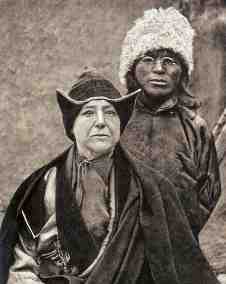SelfDefinition.Org
Tulpa Creation in Tibet

Comments by Walter Evans-Wentz
Also see: Comments by Alexandra David-Néel
Excerpt from Tibetan Book of the Great Liberation
(Evans-Wentz was the translator)
Source: Google Books (search on tul-pa)
Dominion Over Bodily Form
From a footnote on page 29
The Tibetan belief concerning this yoga of dominion over bodily form may be summarized as follows:
Through transcendental direction of that subtle mental faculty, or psychic power, whereby all forms, animate and inanimate, including man’s own form, are created, the human body can either be dissolved, and thereby be made invisible, by yogically inhibiting the faculty, or be made mentally imperceptible to others, and thus equally invisible to them, by changing the body’s rate of vibration. When the mind inhibits emanation of its radio-activity, it ceases to be the source of mental stimuli to others, so that they become unconscious of the presence of an adept of the art, just as they are unconscious of invisible beings living in a rate of vibration unlike their own.
Inasmuch as the mind creates the world of appearances, it can create any particular object desired. The process consists of giving palpable being to a visualization, in very much the same manner as an architect gives concrete expression in three dimensions to his abstract concepts after first having given them expression in the two dimensions of his blue-print.
The Tibetans call the One Mind’s concretized visualization the Khorva (Hkhorva), equivalent to the Sanskrit Sangsāra; that of an incarnate deity, like the Dalai or Tashi Lāma, they call a Tul-ku (Sprul-sku), and that of a magician a Tul-pa (Sprul-pa), meaning a magically produced illusion or creation.
A master of yoga can dissolve a Tul-pa as readily as he can create it; and his own illusory human body, or Tul-ku, he can likewise dissolve, and thus outwit Death. Sometimes, by means of this magic, one human form can be amalgamated with another, as in the instance of the wife of Marpa, guru of Milarepa, who ended her life by incorporating herself in the body of Marpa.
Madame Alexandra David-Néel, who investigated these magical matters among the Tibetans, states that "a phantom horse trots and neighs. The phantom rider who rides it can get off his beast, speak with travellers on the road, and behave in every way like a real person. A phantom house will shelter real travellers, and so on." See With Mystics and Magicians in Tibet [1] (London, 1931, p. 316, and throughout chapter viii), a work to which the Editor gratefully acknowledges assistance.
[1. Appears on page 210 in the 1937 edition on this site. PDF, 228 pages, 608 KB ]
Similarly, a master magician, such as the Great Guru was, can multiply his own or any other illusory form. Madame David-Néel herself, after some months’ practice, succeeded in creating the form of a monk which followed her about and was seen by others. She lost control of it, whereupon it grew inimical; and only after six months of difficult psychic struggle in concentration was she able to dissipate it (cf. ibid., pp. 314–15). [2]
[2. alexandra-david-neel-comments.htm#david-neel-creates ]
In like manner, 'mediums' in the Occident can, while entranced, automatically and unconsciously create materializations which are much less palpable than the consciously produced Tul-pas, by exuding 'ectoplasm' from their own bodies. Similarly, as is suggested by instances of phantasms of the living reported by psychic research, a thought-form may be made to emanate from one human mind and be hallucinatorily perceived by another, although possessed of little or no palpableness.
[ end of footnote ]